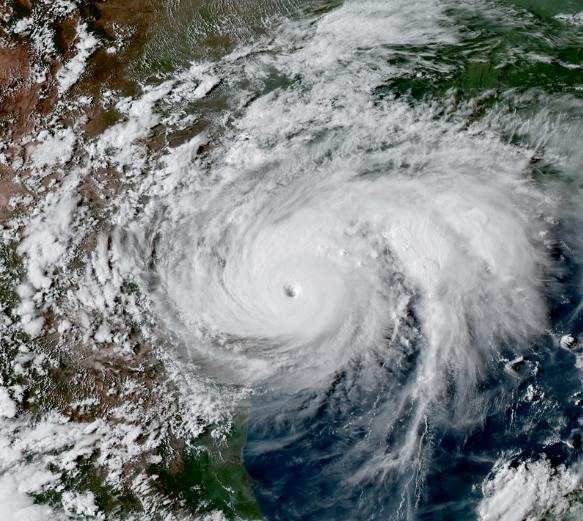15 May 2018
Scientists Indict Harvey for Colluding with Climate Change to Drown Texas
Posted by Dan Satterfield
Title get your attention? Well, it’s true and I don’t write it lightly.
In a paper soon to be published, a group of researchers have run the numbers and found where all the record heat in the waters of the Gulf last summer ended up. The indictment is convincing: The heat was laundered by Hurricane Harvey and ended up all over south Texas disguised as a severe flood.
Seriously, here are the facts, and I’ll warn you they are alarming:
 The oceans are hot right now and not just the top of the ocean, the warm water goes deep. Ocean heat content is a measure of just how much heat energy a slab of ocean water has, and when forecasting a hurricane I look closely at the ocean heat content in the waters under a tropical cyclone. Over 90% of the extra heat trapped by greenhouse gases is going into the oceans which makes ocean heat content a very good indicator of how quickly the planet is heating up. Yes, that graph means what you think it does: Anyone telling you that climate change has stopped has no idea what they’re talking about.
The oceans are hot right now and not just the top of the ocean, the warm water goes deep. Ocean heat content is a measure of just how much heat energy a slab of ocean water has, and when forecasting a hurricane I look closely at the ocean heat content in the waters under a tropical cyclone. Over 90% of the extra heat trapped by greenhouse gases is going into the oceans which makes ocean heat content a very good indicator of how quickly the planet is heating up. Yes, that graph means what you think it does: Anyone telling you that climate change has stopped has no idea what they’re talking about.
With this in mind, here are some findings from the paper (open access) in the AGU journal Earth’s Future by Kevin E. Trenberth, Lijing Cheng, Peter Jacobs, Yongxin Zhang and John Fasullo:
Ocean heat content was highest on record just before northern summer of 2017, supercharging Atlantic hurricanes Harvey, Irma and Maria.
The Gulf of Mexico ocean heat loss during Harvey matched the latent heat released by Harvey rainfall, and thereby fueled the storm.
Essential adaptation to the natural hazards and climate change is not happening in many vulnerable areas, with major consequences.”
The authors basically do a mathematical- thermodynamic accounting of the heat that Harvey robbed from the Gulf of Mexico and find that it ended up as flooding rains in Texas. Importantly: The rain matches the heat loss:
“The bottom line is that the total observed OHC change is remarkably compatible with the total energy released by precipitation, and, unsurprisingly, reflect strong energy exchanges during the hurricane. Accordingly, the record high OHC values not only increased the latent heat which fueled the storm itself, likely increasing its size and intensity, but also likely contributed substantially to the flooding caused by rainfall on land…”
Every meteorologist knows that if you warm the air one degree Celsius it will hold around 5-7% more water vapor. This comes from an equation every meteorologist is familiar with- the Clausius Clapeyron relation, but the line below was a real surprise:
Given that SSTs have increased about 0.6C since 1960 due to anthropogenic climate change there is on average about 5% more moisture in the atmosphere… For Harvey, the amplification has been found to be about 37.7% (Risser & Wehner, 2017) or 20% (13 to 37%) (Wang et al., 2018). A 35% increase in rainfall from climate change would thus be as much as 15 inches (380 mm) in places.
I asked the authors and Dr Trenberth explained that the extra moisture makes the storm stronger and wetter and that 5% is WAY low. This is bad news and it gives some real context to these extreme flood event and even the new 24-hour rain U.S. rain record that appears to have been set in Hawaii.
The paper also criticises Texas and the city of Houston for poor planning and rampant home building in floodplain areas. Co-Author Peter Jacobs pointed out that we can mitigate climate change or we can adapt to it, but Texas seems to be taking a novel new third option:
Suffering the consequences.
This seems to be the preferred option in places where politicians think climate change is a hoax.



 Dan Satterfield has worked as an on air meteorologist for 32 years in Oklahoma, Florida and Alabama. Forecasting weather is Dan's job, but all of Earth Science is his passion. This journal is where Dan writes about things he has too little time for on air. Dan blogs about peer-reviewed Earth science for Junior High level audiences and up.
Dan Satterfield has worked as an on air meteorologist for 32 years in Oklahoma, Florida and Alabama. Forecasting weather is Dan's job, but all of Earth Science is his passion. This journal is where Dan writes about things he has too little time for on air. Dan blogs about peer-reviewed Earth science for Junior High level audiences and up.